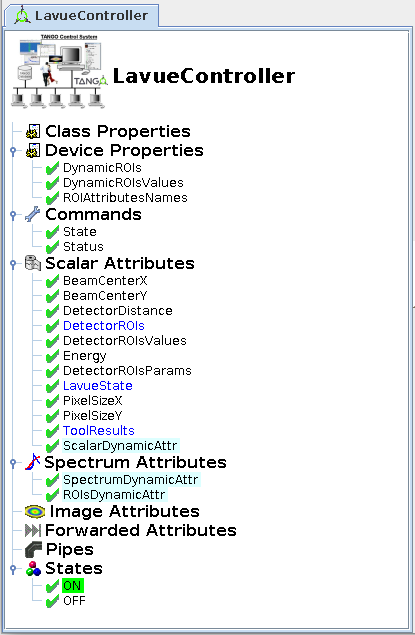LaVueController server¶
LavueController server allows for communication with LaVue GUI via tango interface, e.g. with user scripts or macros

Attributes¶
The user can pass to and read back from the LaVue GUI the following attributes:
BeamCenterX: x-coordinate of the beam center in pixels, e.g. used in Angle/Q Tool
BeamCenterY: y-coordinate of the beam center in pixels, e.g. used in Angle/Q Tool
PixelSizeX: x-size of the detector pixel in micrometers, e.g. used in Angle/Q Tool
PixelSizeY: y-size of the detector pixel in micrometers, e.g. used in Angle/Q Tool
DetectorDistance: detector distance from the sample in mm, e.g. used in Angle/Q Tool
Energy: beam energy in eV, e.g. used in Angle/Q Tool
DetectorROIs: JSON dictionary with Regions Of Interests ranges, e.g.
{"pilatusrois": [[67, 131, 124, 153], [67, 69, 117, 119], [134, 129, 184, 179]]}
Moreover the user can read from the LaVue GUI:
DetectorROIsValues: JSON dictionary with Regions Of Interests sums, e.g.
{"pilatusrois": [8167.0, 2262.0, 478.0, 1069.0]}
DetectorROIsParams: JSON list of image transformations performed by lavue, e.g.
["transpose", "flip-left-right", "flip-up-down"]
ToolResults: JSON dictionary with tool results, i.e. 1d diffractogram plot or position of peaks
Finally, the user can change state of lavue by writing to
LavueState: JSON dictionary with lavue configuration with parameters corresponding to command-line parameters of lavue (to display them: lavue -h). The currently supported commands are: source, configuration, start, stop, imagefile, offset, rangewindow, dsfactor, dsreduction, filters, mbuffer, maskfile, maskhighvalue, transformation, scaling, levels, autofactor, gradient, viewrange, tool, toolconfig, tangodevice, doordevice, analysisdevice, log.
e.g.
import tango
import json
lc = tango.DeviceProxy("p09/lavuecontroller/1")
# start the Test source
lc.LavueState = json.dumps({"source": "test", "start": True})
# stop an image source
lc.LavueState = json.dumps({"stop":True})
# set the hidra source with a server configured
lc.LavueState = json.dumps({"source": "hidra", "configuration": "haspilatus1m.desy.de"})
# start Tango Attribute image source with a tango attribute from TangoTest server
# lc.LavueState = json.dumps({"source": "tangoattr", "configuration": "sys/tg_test/1/double_image_ro", "start": True})
# set ROI tool in the tool combobox
lc.LavueState = json.dumps({"tool": "roi"})
# set display intensity levels
lc.LavueState = json.dumps({"levels": "m20,20"})
# set level auto factor
lc.LavueState = json.dumps({"autofactor": 1})
# set auto levels
lc.LavueState = json.dumps({"autofactor": ""})
# set mask values above
lc.LavueState = json.dumps({"maskhighvalue": 30000})
# set flip-up-down transformation
lc.LavueState = json.dumps({"transformation": "flip-up-down"})
# set log intensity scaling
lc.LavueState = json.dumps({"scaling": "log"})
# set eiger image source with configuration defined by alias "eiger"
# (otherwise you have to set as configuration the whole URL string)
lc.LavueState = json.dumps({"source":"http", "configuration":"eiger", "start":True})
You can read the current LaVue state via LavueState. To update the viewrange parameter write to LavueState an empty JSON dictionary or {"__update__": true}.
Properties¶
The DynamicROIsValues device property can be set to true or false. When it is true dynamic attributes with ROIs sums are added.
They names are defined by ROIs aliases from Lavue GUI.
The DynamicROIs or FloatDynamicROIs device property can be set to true or false. When it is true dynamic attributes with ROIs bounds are added. In the float case ROIs bounds are represented by float numbers.
They names are defined by ROIs aliases from Lavue GUI.
The ROIAttributesNames device property contains names of dynamic attributes which will be created event if the corresponding ROIs aliases in Lavue GUI are missing.